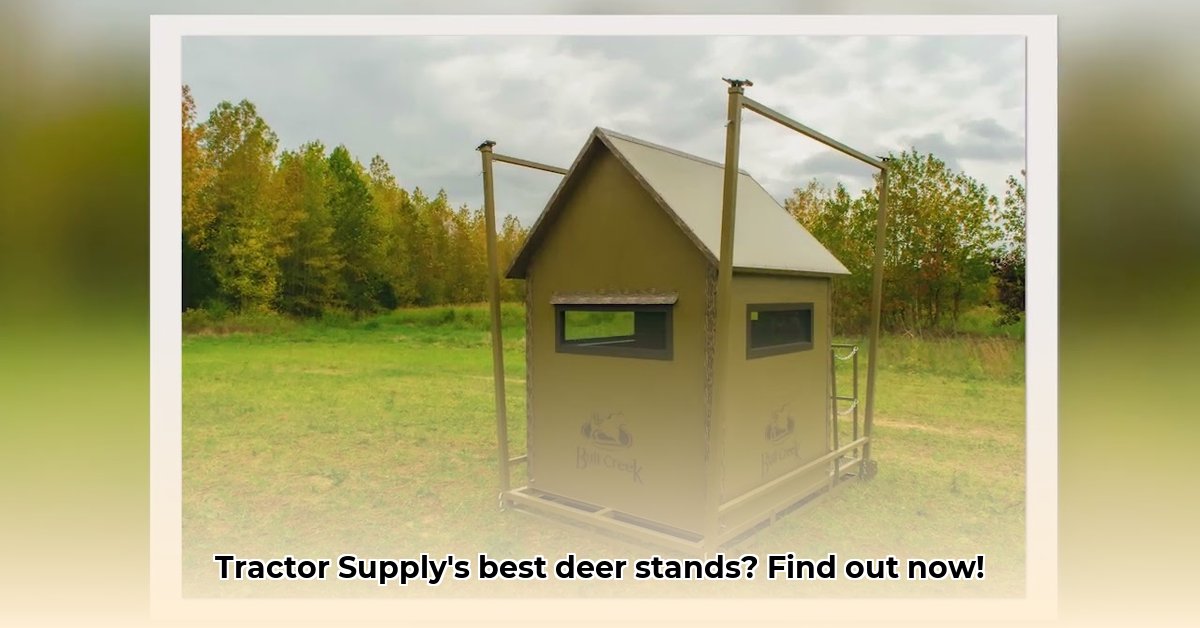
Hunting season is approaching, and securing the perfect deer stand is crucial for a successful hunt. Tractor Supply offers a wide selection, but choosing the right one can be overwhelming. This guide simplifies the process, helping you select, set up, and maintain your ideal deer stand from Tractor Supply. We'll cover various stand types, crucial selection factors, safety protocols, and maintenance tips to maximize your hunting success. For more Tractor Supply deer stand options, check out this helpful resource: Tractor Supply Deer Stands.
Types of Deer Stands at Tractor Supply
Tractor Supply provides diverse deer stand options, each suited to different hunting styles and preferences. Let's explore the most common types:
Ladder Stands: These offer a stable, easy-to-climb structure, ideal for less experienced hunters. However, their bulkier design impacts portability. Think of them as the reliable workhorses of the deer stand world.
Tripod Stands: Lightweight and portable, tripod stands are perfect for remote hunting locations. Their ease of transport comes at a slight cost of stability and concealment compared to ladder stands.
Climbing Stands: Compact and lightweight, climbing stands are exceptionally mobile and easily integrated into the surrounding environment. However, their setup demands more skill and practice for secure placement.
Ground Blinds: Unlike traditional tree stands, ground blinds offer superior concealment by blending seamlessly into the terrain. However, their lack of height may limit visibility and shooting opportunities.
Choosing Your Perfect Tractor Supply Deer Stand
Selecting the right deer stand depends on several key factors. Consider these elements carefully:
Budget: Deer stands vary widely in price. Set a budget upfront to avoid overspending.
Hunting Location: Terrain and vegetation significantly impact stand choice. A heavy-duty ladder stand might be impractical in thick underbrush, while a lighter tripod or climbing stand might be less stable in exposed areas.
Height and Weight Capacity: Sufficient height is essential for optimal visibility, but equally crucial is the stand's weight capacity, ensuring safe operation for you and your gear.
Ease of Setup and Take Down: Select a stand compatible with your skill level and the time constraints of setup and takedown. Consider tools required and any physical limitations.
Comfort and Features: Features such as gun rests, shooting rails, or padded seats enhance comfort during extended hunting periods. Assess which features are essential for your comfort and hunting style.
Durability and Material: Steel stands offer superior robustness, but at the cost of increased weight. Aluminum stands are lighter but potentially less durable depending on the manufacturing quality. Check customer reviews and warranties to confirm durability for your budget.
Setting Up Your Deer Stand: Safety First!
Prioritize safety during stand setup. Follow these critical steps:
Scout Your Location: Thoroughly examine the selected hunting area, choosing a sturdy tree capable of safely supporting the stand's weight, ensuring a clear field of view.
Meticulous Setup: Adhere precisely to the manufacturer's instructions, checking all components for secure fastening and stability. Never compromise on setup for expediency which could compromise safety.
Harness Up: Always use a full-body safety harness, regardless of stand height. This critical safety measure could save your life in case of a fall.
Pre-Hunt Inspection: Conduct a final inspection before each hunt, verifying secure fastenings and noting any signs of wear and tear. Address any potential issues immediately.
Tree Selection: Select a healthy, mature tree with strong, stable branches capable of supporting the stand's weight. Avoid trees exhibiting signs of damage or decay.
Maintaining Your Deer Stand: Extending its Life
Proper maintenance safeguards your stand's longevity and safety. Follow these essential steps:
Post-Hunt Cleaning: After each hunting session, clean the stand, removing dirt, debris, and moisture to prevent rust or corrosion, preserving its structural integrity.
Proper Storage: During the off-season, store the stand in a dry, sheltered location to prevent damage from exposure to the elements.
Regular Inspections: Before each hunting season, conduct a full visual inspection, checking for any damage, loose parts or signs of wear. Repair or replace any damaged components before usage.
Conclusion: Your Successful Hunt Starts Here
Choosing, setting up, and maintaining your deer stand are key factors in ensuring a safe and successful hunting experience. By carefully considering these factors and prioritizing safety, you'll significantly increase your chances of a rewarding hunt. Remember to check Tractor Supply's website 1 for their current range of products.